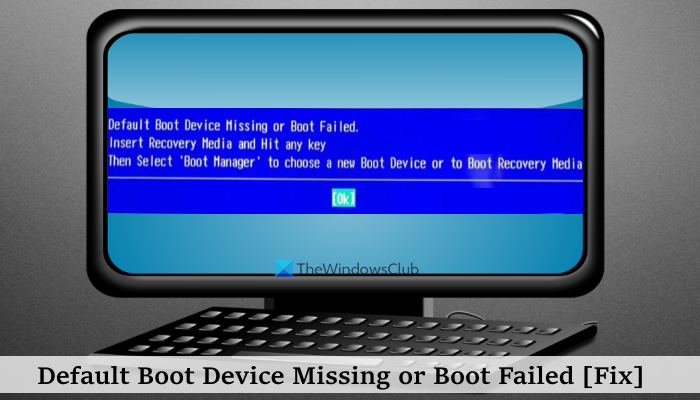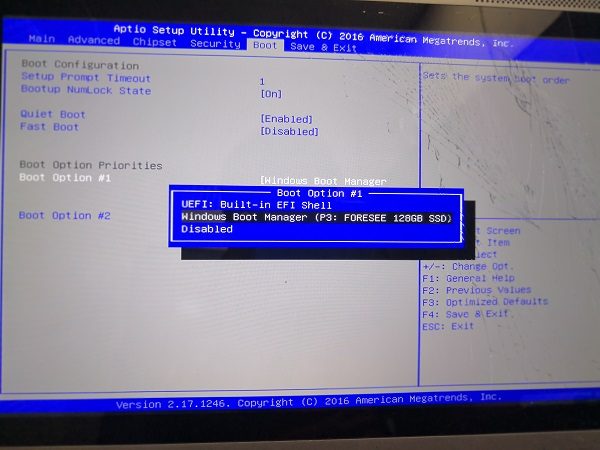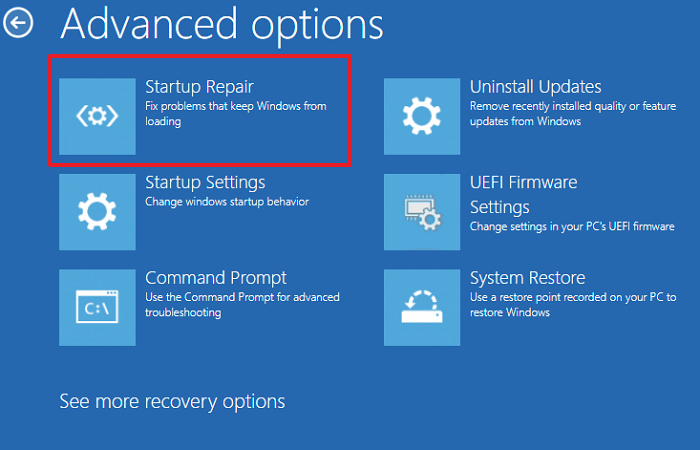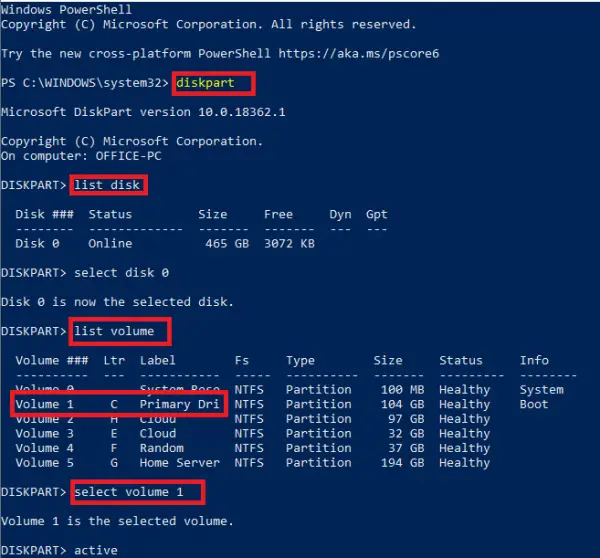Some users have complained about this problem that when they start their computer, it doesn’t boot. Instead, a Default Boot Device Missing or Boot Failed blue colored screen is displayed on their Windows 11/10 system. This error can be caused if the boot sequence or boot order is not correct, Windows boot files are corrupt, the system partition is not set active, there is a problem with the hard drive itself, etc. Below you can see the complete error message for this problem:
Default Boot Device Missing or Boot Failed.
Insert Recovery Media and Hit any key
Then Select ‘Boot Manager’ to choose a new Boot Device or to Boot Recovery Media

Default Boot Device Missing or Boot Failed [Fix]
To fix the Default Boot Device Missing or Boot Failed error in Windows 11/10, use the following fixes. Before that, restart your PC as it worked for one of the affected users.
- Check the boot sequence and boot mode
- Rebuild Boot Configuration Data file
- Perform Windows Startup Repair using Installation Media
- Make sure the Primary Partition is Active
- Reset BIOS settings to default
- Check the hard disk.
Let’s check these solutions one by one.
1] Check the boot sequence and boot mode

This is one of the important solutions to fix this Default Boot Device Missing or Boot Failed problem on your Windows 11/10 system. If the boot order or boot sequence is changed and your hard disk is placed on 2nd or some other position in the boot priority, then your system won’t be able to boot and this error message may appear. So, you should first check the boot sequence and correct it. In addition, you also make sure that the correct boot mode is selected. To check and change the boot order and boot mode, follow these steps:
- Turn off Windows 11/10 PC or laptop
- Press the Power button and repeatedly press a function key which is supported for your PC/laptop to enter into the BIOS setup. For example, if you are using HP laptop/computer, then use the F10 key to access the BIOS setup
- In BIOS setup, switch to the Boot tab using the arrow keys
- Look for the boot priority mode or Boot Option Priority. If your boot hard disk is not present in the first position, then change the boot sequence to set your hard disk on the top. You need to use arrow keys and then press the Enter key to set the Boot Option Priority
- Now set the Boot Mode to Legacy Support (if using MBR partition disk) or UEFI (if using GPT system disk) available in the same tab
- Press the F10 hotkey to Save and Exit.
Now your system should boot and the problem will be fixed.
Read: No bootable image found, notebook will shutdown
2] Perform Windows Startup Repair using Installation Media

Startup Repair is a built-in feature of Windows 11/10. If there is some problem with boot files that are needed to start an operating system, then the Startup Repair feature can help you find and fix those files. Since you can’t boot into your system, you need to perform Startup Repair using installation media for your Windows 11/10 system.
You first need to create a Windows bootable USB or DVD drive using another system and connect it to your system. Now boot from the installation media and the Windows installation setup will appear. You don’t have to perform the installation process. Instead, in the Windows installation setup, click on the Repair your computer option.
Now select Troubleshoot > Advanced options > Startup Repair. Follow the given instructions to start the diagnosis and fix the issues. This should work.
Related: Hard Drive not showing up on Boot Menu in Windows PC
3] Rebuild Boot Configuration Data file
Rebuild the BCD file. BCD or otherwise known as Boot Configuration Data contains boot configuration parameters on how to start your Windows. If the configuration file gets corrupted, you will have to rebuild BCD or Boot Configuration Data file. Usually, when BCD gets corrupted, it results in unbootable situations
4] Make sure the Primary Partition is Active

If the primary partition where Windows is located or installed is not set as the active partition, then also Windows will fail to boot and you may see this Default Boot Device Missing or Boot Failed error. So, to fix this, make sure the primary partition is set as the active partition. Again, as you are not able to boot in Windows, you will need to use a Windows installation media for it. Connect the installation media and follow these steps:
- When the Windows Setup screen appears after connecting the installation media, use the Repair your computer option
- Select the Troubleshoot option
- Access Advanced options and click on Command Prompt to open an elevated CMD window
- Type
diskpartcommand and press Enter - Execute
list diskcommand and the available hard disks will visible in the Command Prompt window with disk numbers like Disk 0, Disk 1, Disk 2, etc., disk size, and other information - Select your hard disk. For example, if your hard disk is Disk 0, then execute
select disk 0command to select it - Execute
list partitionorlist volumecommand to view the available partitions for your hard disk - Now select the primary partition where Windows is installed. So, if Windows is installed in partition 1, then execute
select partition 1command - Finally, execute
activecommand and your primary partition will be set as active - Close the CMD window
- Disconnect the installation media USB or DVD drive and restart your system
- Now the system should detect the primary partition and boot Windows.
5] Reset BIOS settings to default
If the above solutions don’t help and Windows is failed to boot or load the operating system, then you should reset BIOS settings to default. After resetting BIOS to default values, you should also set the boot order, boot mode, etc. Now check if the operating system starts.
Read: No bootfile found for UEFI! Maybe the image does not support x64 UEFI
6] Check the hard disk
Check if your hard drive is connected properly to your PC as a loose connection can make the hard drive inaccessible. It might also be possible that your hard disk is corrupted or defective. The best option to check the hard disk is to head to the authorized service center and let the technician check it. If the hard disk can be repaired or data can be recovered, then it’s well and good as you can then re-install Windows. But, in case of a hard drive failure, you need to replace it. If the hard disk warranty is expired, you have to buy a new hard disk.
I hope this will be helpful.
TIP: Disabling Local Security Authority protection is known to have helped many resolve this issue.
How do I fix failed boot device?
If you try to use a USB drive or DVD disk to boot from for installing Windows and you receive The selected boot device failed error, then first, disable Secure Boot on your Windows 11/10 system to fix the issue. If that doesn’t help, then properly create an installation media using Media Creation Tool or make a bootable USB drive using Rufus or another popular tool and then try again to solve the problem.
How do I fix my BIOS boot device?
If you turn on your system and instead of loading the OS, it shows a Boot Device Not Found error and prompts you to install an operating system on your hard disk, then you should check the connection with the boot drive. Make sure the cable is well attached to the boot drive and motherboard. If the problem is not solved, use a bootable USB drive to boot into Advanced Recovery mode, and then re-build Boot Configuration Data using the bootrec /rebuildbcd command in the Command Prompt window.
Read next: Fix 0xc0000225, Boot selection failed because a required device is inaccessible.
Leave a Reply